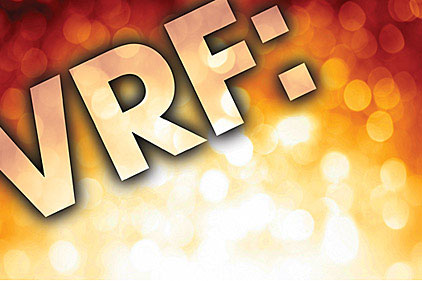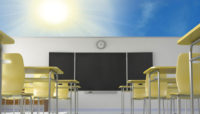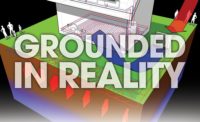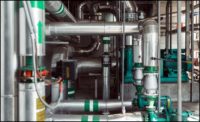WHAT IS VRF?
A VRF system is a direct expansion (DX) HVAC system consisting of at least one variable capacity compressor connected to two or more independently-controllable fancoil units on a single refrigerant piping network. Most VRF systems available today also include a variety of indoor units including: ducted units, wall-mounted units, and cassette-type units that will fit into a standard 2- x 2-ft ceiling grid.
VRF systems generally include proprietary controls systems that modulate fans, compressors, and electronic expansion valves to ensure the highest efficiency of the system. These controls systems can also include advanced features such as remote monitoring (through a building network or over the internet), BMS interface modules, and central control systems capable of handling up to 2,000 indoor units.
One common misunderstanding in the HVAC community is that all VRF systems have the ability to simultaneously heat and cool. This is not the case. While many VRF manufacturers offer systems that are able to heat and cool simultaneously, many also offer a heat pump version where all indoor units must be in the same mode. At first glance, it would seem that most users would prefer the additional benefit of simultaneous operation; however, there are advantages and disadvantages to each that must be considered. In other markets around the world, heat pump VRF systems represent almost 70% of all VRF installations.
Both heat pump VRF systems and heat recovery VRF systems provide unique benefits and both have their strengths and weaknesses. When designing a system, it is important to evaluate all of these attributes to determine the best solution for the customer.
HEAT PUMP VRF
A heat pump VRF system operates all of the indoor units in the same mode (either heating or cooling). If any indoor unit (other than the “master” unit) changes mode, it goes into standby until the outdoor unit changes mode. There are several different ways to change the mode of the system: manual changeover (changing mode from the central controller, averaging (mode changes to meet the needs of the majority of indoor units), external input (mode can be controlled by third-party input such as an outdoor temperature sensor or a switch in the mechanical room), master controller (the system can be programmed so that the mode of a single air handler [usually in the boss’ office] will determine the mode of the entire system), and automatic changeover (mode changes when room temperature exceeds set temperature [by 4° to 8°] in the master controller’s zone).
HEAT RECOVERY VRF
In a heat recovery VRF system, the energy recovered from the indoor units operating in one mode can be transferred to one or more indoor units operating in the other mode. In most cases, a heat recovery system can provide the mode necessary (heating or cooling) to meet the needs of the space, subject to design constraints and manufacturer’s limitations. These limitations and acceptable operation ranges vary between manufacturers, so it is important to consult the manufacturer’s design and technical manual when designing a heat recovery VRF system.
CHOOSING THE RIGHT SYSTEM
The primary benefit of a heat recovery VRF system is that it gives each occupant the ability to control the mode and the temperature of their individual AHU. Heat recovery VRF systems also have the potential to produce additional energy savings at times when an equal capacity of units are in heating that are in cooling. If a VRF system can keep heat energy inside of the building instead of producing additional heat, there is potential for additional savings. This is especially practical for buildings with large floor plans where the perimeter units might need heat while the core requires cooling or when rooms have heavy occupancy loads, such as a cafeteria or conference room. These spaces frequently require cooling when they are at full capacity.
The additional energy savings possible using a heat recovery VRF system varies based on location and application. In some cases, having heat recovery could result in increased energy consumption based on higher compressor run time. Also, the months when heat recovery is most commonly used, such as the shoulder seasons in the spring and fall, represent only a small percentage of the total energy load of a building. So even though heat recovery produces some savings during this time, it is only a small percentage of total annual energy consumption.
One of the primary reasons for choosing heat pump VRF over heat recovery is cost. For a VRF system to provide simultaneous heating and cooling, additional components are required to alternate the flow of liquid refrigerant or hot gas. These controllers, called a “branch box” or “BC controller, contain valves to control the flow of refrigerant.
BC controller boxes, a requirement for two-pipe VRF systems, include liquid/gas separators and a tube-in-tube heat exchanger in addition to the multiple refrigerant flow control valves. A BC controller can contain up to 16 separate circuits, each with independent valves. When installing these systems, it is a good practice to locate these in an area that has adequate room for servicing and where occupants will not be distracted by the valve or refrigerant noise.
The ability to deliver heating or cooling simultaneously also requires additional copper refrigerant piping. A system that utilizes a BC controller requires all indoor units on each segment (up to 16) to “home run” back to the BC controller. For a three-pipe heat recovery system, each refrigerant run will require a third pipe to each branch box then two pipes to each air handler. While a two-pipe system can reduce total piping, in some cases, the longer piping runs required to reach the BC controller can diminish this benefit. Also, a two-pipe system still requires three pipes when more than one BC controller is used. With both the two-pipe and three-pipe systems, the additional components increase the total installed cost of a project. In most cases, heat recovery VRF projects cost 30% to 40% more than a similarly sized heat pump VRF system.
Heat recovery systems also have a limited operating range based on outside air temperature. This range, which varies by manufacturer and condenser mode, can be as limited as 23°F to 60° for simultaneous operation. This could mean that any time the outside air temperature exceeds this range, the VRF system would need to operate in 100% heating or 100% cooling. These restrictions can greatly limit the usefulness of a simultaneous system.
The temperature limitations for heat recovery VRF also make it impractical to connect a heat recovery VRF system to a server room or other mechanical space requiring year-round cooling. If other areas of the building call for heating when the outdoor temperature is below the manufacturers limitations, the performance of the system may become unstable or unreliable. These types of applications should always consider the use of a dedicated heat pump system or, in the case of server rooms, a specialized computer room cooling system.
The temperature limitations for VRF also limit the use of VRF for building core cooling in winter. Core heat can become a greater concern as outdoor temperatures decrease. The limit for simultaneous operation for many VRF manufacturers is 23°. Therefore, it may still become necessary to design with a supplemental cooling source for the building core. If such a system is necessary, this limits the benefits and energy savings of the heat recovery system.
VRF APPLICATIONS
There are many applications where simultaneous heating and cooling is an excellent solution. For example, a building that is considering a conventional four-pipe fancoil system would benefit from VRF. A heat recovery VRF system has the ability to provide heating and cooling for this space at a much lower installed cost. VRF systems also tend to have much higher efficiency than a four-pipe system. The combination of lower installed cost and lower operating cost makes this a very attractive solution.
Another common application for a simultaneous system is a high-end hotel. Guests who stay in high-end hotels demand the ability to control the mode and temperature of their individual AHU, and a heat recovery VRF system is able to meet the needs of these guests. Other spaces such as hallways, conference rooms, or lobbies could be on a separate heat pump VRF system, since these indoor units serving a large space would all be in the same mode. Through proper design, the system can be designed to provide the best solution for this application.
A common application for a heat pump system is a school. While many schools would benefit from a heat recovery system, the lower installed cost of a heat pump system makes this a very popular solution. Proper system design also reduces the need for a heat recovery system. By designing the refrigerant circuits so that all of the rooms with the same exposure are on the same system, heat recovery may become unnecessary and an unjustified extra expense.
Another common application for a heat pump VRF system is a church. The design of the HVAC system for a church is often based on the loads in the space where services are held. This is usually a very large space that will always have all of the indoor units in the same mode. This system can also be zoned such that the load can be shifted to other areas within the building, such as offices or classrooms. For these applications, a heat pump VRF system can be zoned to make sure these spaces will receive the required heating or cooling when needed.
PROPER EVALUATION AND DESIGN
When designing a VRF system, it is important for the designer to evaluate the needs of the space to determine the most cost effective solution for the enduser. If the enduser believes all of the AHUs will be in the same mode for most of the year (a common feature of most conventional U.S. systems), it would be unnecessary for the owner to incur the additional expense of a heat recovery system. But, if a building has greater diversity or is seeking greater flexibility, there may be a benefit in incurring the additional expense of a heat recovery system.
While VRF is a mature technology in most of the world; it is still in its infancy in the U.S.. There are still many types of applications that will benefit greatly from the features offered by a VRF system. Each successful VRF installation will create many future opportunities for contractors and engineers. Managing projects effectively and ensuring proper design and application will pay off even greater returns for design professionals. ES






